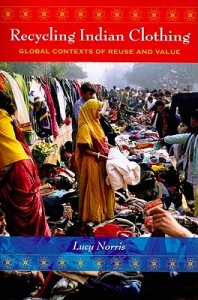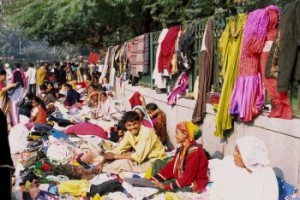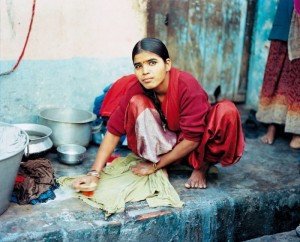 Recycling Indian Clothing – Global Contexts of Reuse and Value
Recycling Indian Clothing – Global Contexts of Reuse and Value
Author: Lucy Norris
ISBN: 9780253222084
The normal ‘science’ of clothing recycling supply chains busies itself with looking how Western clothing is shipped, and then either sold to or processed by, citizens in developing countries commonly thrown into the coarsely labelled category of ‘bottom of the pyramid). Arguments brought to the table cover a broad field: charity, compassion, admiration for these person’s business sense, the undermining of local textile industries and so forth.
None of this, or at least very, very little, is to be found in this book.
This book emerges itself into how clothing is bought, worn, discarded and recycled within India. In other words, it tracks down how Indian citizens (primarily women) manage their wardrobes, and the strategies and criteria of how they do it. The world beyond the geographical Indian border rarely seeps into the observation, and if it does, then quite accurately to make a point that in the present the globe really is global. And what we see is side effects of this globalisation that are seeping into a clothing and textile culture that otherwise remains to a vast extent surprisingly little affected by the galloping changes we have experiences in Europe (and the US) over the past century.
The book is the summary of what was originally conceived – just like Salaula – as an ethnological study.
The author thereby spent long periods of time in the country, interviewing her neighbours, clothing producers, recyclers and sellers; observing how second hand clothing markets function, and how value is generated of nearly every single fibre of a piece of cloth; and finally finding out about the cultural and historical context that keeps influencing consumer buying, wearing and discarding behaviour, as well as processes and techniques in levering what ever value there is left over.
The book is, unsurprisingly, brimming with insights and surprises that have novelty value, and very likely never have been pointed out as directly. Here a selection of what seem to me the most surprising of all facts.

- Clothing overconsumption exists also in India. It is mostly confined to the upper and middle classes, but it is equally blatant as in the West. Just the mechanisms are different. Much of the overconsumption is due to ‘giving’ traditions in the Indian calendar of festivities, or in relation to social occasions (births, marriages, family gatherings etc.).
- Most of the clothes accumulated have a very real (high) material value. But even in a culture where the maker’s craftsmanship is intrinsic part of the value of a Saree for example, ‘fast fashion type’ of clothing do exist. In the present, Sarees from man-made fibres are cheap and cheerful, and that’s what they’re seen for.
- ‘Used’ clothing can have 2 very distinct flavours: That of emotional bonds, and that of material lack and poverty.
Clothes inherited and received by dearly loved family members fall evidently into the former category. Needless to say that they are treated with utmost care. Not because the clothes are worth it (they very well may), but because of the emotions attached to them, and the respect earned by the previous wearer.
Used-clothing received or bought, and worn out of necessity is equally cared for. But this is out of economic need, and the wearer is well aware that it is an obligation s/he cannot escape. As a consequence, opportunities to impose one’s own taste and preference, while few, are actively sought for, or even invented. Poverty does not imply a lack of taste or style – but it does imply a lack of opportunity to express personal preferences easily.

Some of the most fascinating readings in this books are made up by the observations by the author of ‘used-clothing economy’ and its mechanism: the bartering about clothing happening between house wives a Whari woman; the business model of the Whagri’s trade; the trading of the Press Whala; the hierarchies that exist among traders at second-hand markets in e.g. Dheli; the recovering of metal from Zari-embroidered cloth in Bazaars; the creation of home accessories specifically for the export market. And so on.
And beyond clothing as physical product, once again it becomes very evident that neither fashion, nor clothing can exist outside of a cultural context.
Cultural context defines what is acceptable, what is beautiful. It also defines where the social divide between classes (or casts, in this case, too) runs, and how groups and individuals either cope with them, or invent ways our to circumvent the restrictions.
In short: This book is a demanding, very dense, but highly interesting read. It complements much of the literature existent on recycling of clothing. The fact that it deals with one specific national and cultural context makes it even more relevant as it illuminates the topic from a entirely new angle.
It is a relevant and valuable complement to ‘Salaula‘ on the one hand, and ‘The Travels of a T-Shirt‘ on the other.
—
This book is available from your nearest book store as well as online from Amazon.

